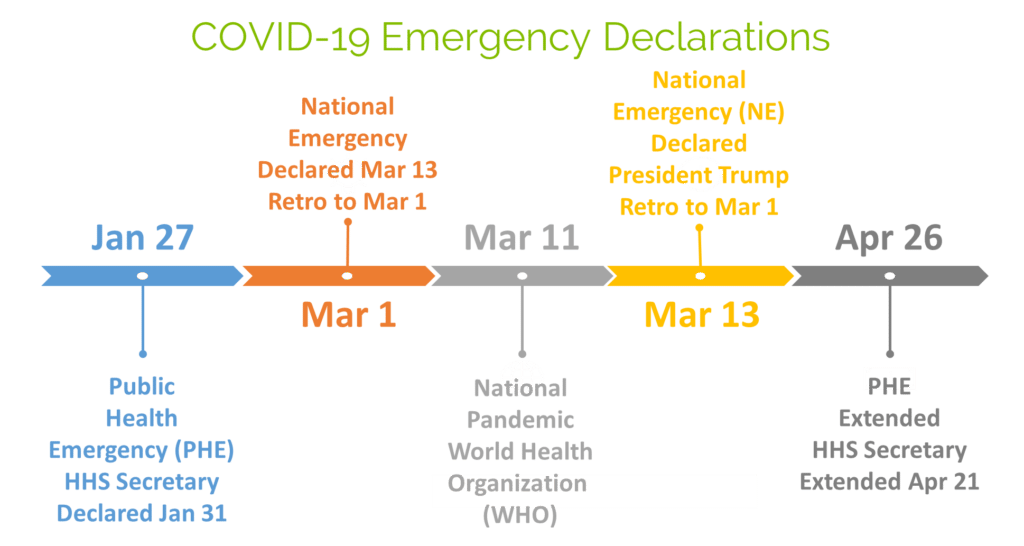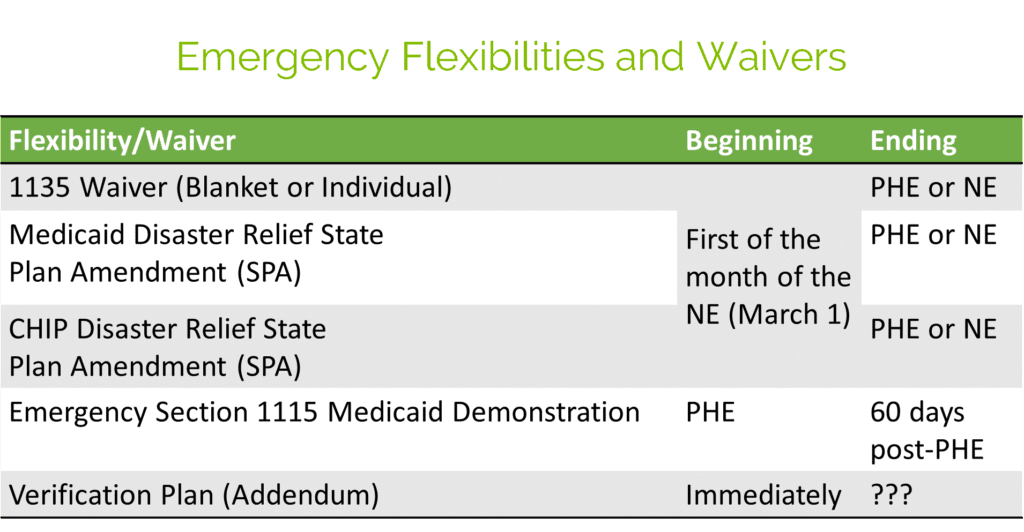COVID-19 Emergency Declarations, Flexibilities and Waivers
Note: Since publication, the Public Health Emergency (PHE) has been extended to October 13, 2022.
“Unprecedented” is a word you hear frequently these days and for good reason. Never in our lifetimes has the world experienced what is happening right now with the COVID-19 pandemic and its implications. This is especially true when it comes to emergency declarations and healthcare-related flexibilities and waivers in the United States. Staying on top of these changes can be more than a full-time job.
Emergency Declarations
On January 31, Health and Human Services Secretary Alex Azar declared a nationwide Public Health Emergency (PHE) retroactive to January 27. President Trump proclaimed a National Emergency (NE) under the Robert T. Stafford Disaster Relief and Emergency Act on March 13, retroactive to March 1. The declarations of both the Public Health Emergency and the National Emergency allow for flexibilities not otherwise available, such as 1135 Waivers. Additionally, all 50 states have announced major disaster declarations for the first time in U.S. history.
There is no time limit on the duration of a National Emergency. The President has discretion as to when to declare and when to terminate it. In contrast, the declaration of a Public Health Emergency is subject to a 90-day time limit. It may be renewed for additional periods, but renewals are also subject to the 90-day limit. Effective April 26, Alex Azar extended the Public Health Emergency out to July 25. It is difficult to predict what will happen after this. Keep in mind that Public Health Emergencies can be targeted to specific areas of the country and do not have to cover the entire country at once. These declarations are important because of the flexibilities associated with them.

Flexibilities and Waivers
Tracking of all the emergency flexibilities and waivers available as a result of the Public Health and National Emergency declarations can be complicated. If you have been tasked with this job, Centauri Health Solutions can help. The table below simplifies the complexity.

1135 Waivers
1135 Waivers have been the most visible. They apply to certain federal Medicare, Medicaid, CHIP, and HIPAA requirements. 1135 Waivers support health care providers and can take the form of a blanket or individual waiver. A blanket waiver applies to everyone and without a request. An individual 1135 Waiver is applied for and must be approved. For the first time in history, all 50 states have an approved 1135 Waiver, and many states have more than one.
Disaster Relief State Plan Amendments
A Medicaid Disaster Relief State Plan Amendment (SPA) offers states the opportunity to apply for flexibilities with their Medicaid programs. The Children’s Health Insurance Program (CHIP) Disaster Relief SPA offers states that have a separate CHIP plan, the opportunity to apply for flexibilities with their CHIP program. A disaster relief Medicaid or CHIP SPA must be approved by the Centers for Medicare and Medicaid Services (CMS) and may only have one effective date. Provisions within the SPA may have different implementation dates after the effective date.
Emergency Section 1115 Medicaid Demonstrations
Emergency Section 1115 Medicaid Demonstrations are used for experimental, pilot or demonstration projects and must be approved by CMS. They can be new or modify an existing 1115 Waiver. The normal public notice process requirements can be waived if the state meets the criteria. Disaster-related demonstrations can be retroactive to the date of the Public Health Emergency. Currently only Washington State has been approved. There are quite a few of these Emergency Section 1115 Medicaid Demonstrations pending and CMS is delayed in processing them.
Verification Plan Addendum
A Verification Plan describes a state’s verification policies for determining eligibility. During a Public Health Emergency, a state can submit a Verification Plan Addendum to temporarily alter their policies and procedures, effective immediately. CMS approval is not required.
Expiration of Flexibilities and Waivers
When the National or Public Health Emergency declaration ends, including any renewals, most of the flexibilities are supposed to end. Emergency Section 1115 Medicaid Demonstrations end 60 days after the Public Health Emergency ends. CMS, however, is unlikely to put a hard stop to the 130 plus waivers related to Medicare and more than 150 waivers related to Medicaid, according to Kim Brandt, CMS’ principal deputy administrator for policy and operations. CMS is working with the White House on a “glide path” to phase them out gradually instead of a hard stop. Some will remain permanently.
What’s Next
States are advised to be watchful for CMS communications on the end date for flexibilities and waivers. Centauri Health Solutions is available to help and support providers and health plans alike.
Shanna Hanson, FHFMA, ACB
Manager, Business Knowledge
Centauri Health Solutions, Inc.